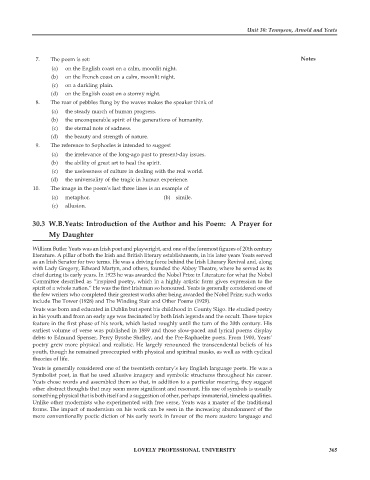Page 372 - DENG405_BRITISH_POETRY
P. 372
Unit 30: Tennyson, Arnold and Yeats
7. The poem is set: Notes
(a) on the English coast on a calm, moonlit night.
(b) on the French coast on a calm, moonlit night.
(c) on a darkling plain.
(d) on the English coast on a stormy night.
8. The roar of pebbles flung by the waves makes the speaker think of
(a) the steady march of human progress.
(b) the unconquerable spirit of the generations of humanity.
(c) the eternal note of sadness.
(d) the beauty and strength of nature.
9. The reference to Sophocles is intended to suggest
(a) the irrelevance of the long-ago past to present-day issues.
(b) the ability of great art to heal the spirit.
(c) the uselessness of culture in dealing with the real world.
(d) the universality of the tragic in human experience.
10. The image in the poem’s last three lines is an example of
(a) metaphor. (b) simile.
(c) allusion.
30.3 W.B.Yeats: Introduction of the Author and his Poem: A Prayer for
My Daughter
William Butler Yeats was an Irish poet and playwright, and one of the foremost figures of 20th century
literature. A pillar of both the Irish and British literary establishments, in his later years Yeats served
as an Irish Senator for two terms. He was a driving force behind the Irish Literary Revival and, along
with Lady Gregory, Edward Martyn, and others, founded the Abbey Theatre, where he served as its
chief during its early years. In 1923 he was awarded the Nobel Prize in Literature for what the Nobel
Committee described as “inspired poetry, which in a highly artistic form gives expression to the
spirit of a whole nation.” He was the first Irishman so honoured. Yeats is generally considered one of
the few writers who completed their greatest works after being awarded the Nobel Prize; such works
include The Tower (1928) and The Winding Stair and Other Poems (1929).
Yeats was born and educated in Dublin but spent his childhood in County Sligo. He studied poetry
in his youth and from an early age was fascinated by both Irish legends and the occult. Those topics
feature in the first phase of his work, which lasted roughly until the turn of the 20th century. His
earliest volume of verse was published in 1889 and those slow-paced and lyrical poems display
debts to Edmund Spenser, Percy Bysshe Shelley, and the Pre-Raphaelite poets. From 1900, Yeats’
poetry grew more physical and realistic. He largely renounced the transcendental beliefs of his
youth, though he remained preoccupied with physical and spiritual masks, as well as with cyclical
theories of life.
Yeats is generally considered one of the twentieth century’s key English language poets. He was a
Symbolist poet, in that he used allusive imagery and symbolic structures throughout his career.
Yeats chose words and assembled them so that, in addition to a particular meaning, they suggest
other abstract thoughts that may seem more significant and resonant. His use of symbols is usually
something physical that is both itself and a suggestion of other, perhaps immaterial, timeless qualities.
Unlike other modernists who experimented with free verse, Yeats was a master of the traditional
forms. The impact of modernism on his work can be seen in the increasing abandonment of the
more conventionally poetic diction of his early work in favour of the more austere language and
LOVELY PROFESSIONAL UNIVERSITY 365

